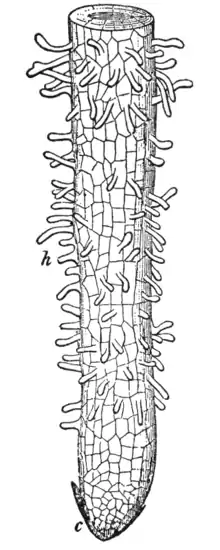Root hair
A root hair,[1] or absorbent hair, the rhizoid of a vascular plant, is a tubular outgrowth of a trichoblast, a hair-forming cell on the epidermis of a plant root. They are lateral extensions of a single cell and are only rarely branched. They are visible to the naked eye and the light microscope. They are found only in the region of maturation of the root. Just prior to and during root hair cell development, there is elevated phosphorylase activity.[2] Plants absorb water from the soil by osmosis. Root hair cells are adapted for this by having a large surface area to speed up osmosis. Another adaptation that they have is a large permanent vacuole.

Function
Root hairs are where most water absorption happens. They are long and so they can penetrate between soil particles, and prevent harmful bacterial organisms from entering the plant through the xylem vessels. They have a large surface area for absorption of water. Increasing root surface area aids plants to be more efficient in absorbing nutrients and establishing relationships with microbes.[3] Cross-section of root hair cell: a roughly rectangular shape with a long, thin tail extending to the right and a nucleus at the top left. Water passes from the soil water to the root hair cell’s cytoplasm by osmosis. This happens because the soil water has a higher water potential than the root hair cell cytoplasm. The function of root hairs is to collect water and mineral nutrients that are present in the soil and take this solution up through the roots to the rest of the plant. As root hair cells do not carry out photosynthesis, they do not contain chloroplasts.
Formation
Root hair cells are outgrowths at a tip of the plant's roots. Root hair cells vary between 15 and 17 micrometres in diameter, and 80 to 1,500 micrometres in length.[4] They are found only in the zone of maturation, and not the zone of elongation, possibly because any root hairs that arise are sheared off as the root elongates and moves through the soil. Root hairs grow quickly, at least 1μm/min, making them particularly useful for research on cell expansion.[5]
Importance
Root hairs form an important surface as they are needed to absorb most of the water and nutrients needed for the plant. They are also directly involved in the formation of root nodules in legume plants. The root hairs curl around the bacteria which allows for the formation of an infection thread through into the dividing cortical cells to form the nodule.[6]
Having a large surface area, the active uptake of water and minerals through root hairs is highly efficient. Root hair cells also secrete acid (H+ from malic acid) which exchanges and helps solubilize the minerals into ionic form, making the ions easier to absorb.[7]
Survival
Root hair cells can survive for 2 to 3 weeks[8] and then die off; at the same time, new root hair cells are continually being formed at the tip of the root. This way, the root hair coverage stays the same. When a new root hair cell grows, it excretes a hormone so that the other cells in close proximity to it are unable to grow one of these hairs. This ensures equal and efficient distribution of the actual hairs on these cells.
The act of re-potting or transplanting a plant can result in root hair cells being pulled off, perhaps to a significant extent, and such plants may therefore wilt for some time as a result.
See also
References
- Grierson, Claire; Schiefelbein, John (2002-04-04). "Root Hairs". The Arabidopsis Book / American Society of Plant Biologists. 1: e0060. doi:10.1199/tab.0060. ISSN 1543-8120. PMC 3243358. PMID 22303213.
- Dosier, Larry W.; Riopel, J. L. (1977). "Differential Enzyme Activity During Trichoblast Differentiation in Elodea Canadensis". American Journal of Botany. 64 (9): 1049–1056. doi:10.1002/j.1537-2197.1977.tb10794.x.
- Grierson, C.; Schiefelbein, J. (2002). "Root Hairs". The Arabidopsis Book. 1: e0060. doi:10.1199/tab.0060. PMC 3243358. PMID 22303213.
- Dittmar, cited in Esau, 1965
- Grierson, Claire; Schiefelbein, John (1 January 2002). "Root Hairs". The Arabidopsis Book. 1: e0060. doi:10.1199/tab.0060. PMC 3243358. PMID 22303213.
- Mergaert, Peter; Uchiumi, Toshiki; Alunni, Benoît; Evanno, Gwénaëlle; Cheron, Angélique; Catrice, Olivier; Mausset, Anne-Elisabeth; Barloy-Hubler, Frédérique; Galibert, Francis; Kondorosi, Adam; Kondorosi, Eva (28 March 2006). "Eukaryotic control on bacterial cell cycle and differentiation in the Rhizobium–legume symbiosis". Proceedings of the National Academy of Sciences. 103 (13): 5230–5235. Bibcode:2006PNAS..103.5230M. doi:10.1073/pnas.0600912103. PMC 1458823. PMID 16547129.
- Gerke, Jörg; Römer, Wilhelm; Jungk, Albrecht (1994). "The excretion of citric and malic acid by proteoid roots ofLupinus albus L.; effects on soil solution concentrations of phosphate, iron, and aluminum in the proteoid rhizosphere in samples of an oxisol and a luvisol". Zeitschrift für Pflanzenernährung und Bodenkunde. 157 (4): 289–294. doi:10.1002/jpln.19941570408.
- "Root hair cells". prezi.com. Retrieved 2018-10-04.